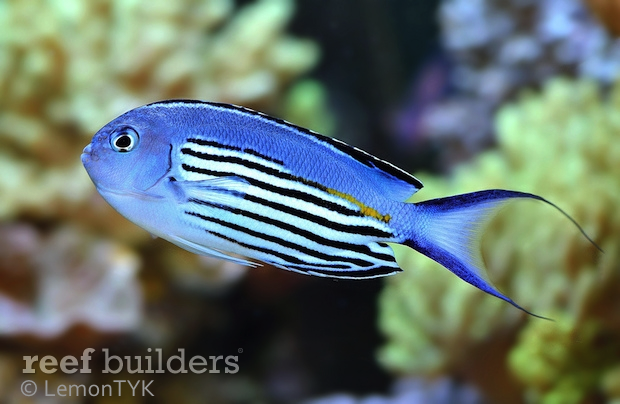Today’s Awesome Fish Spotlight features a member from the angelfish family Genicanthus, which features medium to large plankton feeding species that sport unusually long tail filaments. Like the colloquial name “swallowtail angels” suggests, Genicanthus are noted for their markedly long filamentous extensions on both caudal lobes in both sexes. This genus of angelfish stands apart from the rest in the family based on a few properties, but most importantly for us aquarists are their feeding style and their sexual dichromatism.

All Genicanthus angels are protogynous hermaphrodites, which means they start life as females and have the ability to morph into males. Their social standing dictates if and when they are allowed to start their morphing. In the wild, Genicanthus live in a pseudo-haremic style, or more appropriately, a lek system, where large males dominate certain territories. Females, which out number the males, swim freely amongst the territories set by the males are have no qualms with conspecifics. The males entice the females when they are ready to mate by swimming on their side and quivering his fins and tail. The most dominant and biggest male will breed more freely and frequently with smaller females.
An interesting and classic characteristic of this genus are the prominent sexual dichromatism between the sexes. All ten members of the Genicanthus genus can be differentiated between the genders by colour. The female, although not always (as seen in G. bellus), are usually less colourful and gaudily marked as compared to the males. In the trade, only seven out of the ten species are available; they are, G. watanabei, G. bellus, G. melanospilos, G. lamarck, G. personatus, G. caudovittatus and G. semifasciatus. G. takeuchii, G. semicinctus and G. spinus are unavailable due to isolated range or legality issues regarding collection.

The feeding style of Genicanthus angels are also unique to this genus, and they specialise in catching planktonic particles high above the reef. Unlike most angelfish that pick off the reef, Genicanthus have left the benthic scene and are primarily feeders of plankton. Like Pseudanthias and Paracheilinus, Genicanthus swim above the reef and pick zooplankton as well as pelagic tunicates off the water column. Their small teeth and small mouth are adapted not at picking off algae and other coralline growth, but rather are more adept at catching floating food particles. Their streamline body and long caudal extensions are also more suited for open water swimming as compared to the tightly compressed bodies needed to manoeuvre in a reef labyrinth.
This is great news for aquarist who want to maintain angelfish in a reef system but are too afraid to let that precious Scolymia or Acanthastrea anywhere near one. Genicanthus angels are the safest thing you have to an angelfish, and there’s probably a higher chance a surgeonfish would eat your Zoanthids as compared to a Genicanthus. Their bright colours and sexual dichromatism means that it is easy for aquarist to sex the species, and their tolerance for conspecifics means that a pair, or a small “harem” can be maintained in a large enough system. Being primarily open water swimmers, a small tank size with a cluttered aquascape is a definite no.

In the wild, the range of certain species overlap and even mix, such as G. lamarck + G. melanospilos, and G. semifasciatus + G. takeuchii etc. Hybrids are not uncommon between overlapping species, and while they do mix pretty well in the wild, it is not advisable to keep anything more than one species in one system. Unless you have a very large (think public aquarium) tank, a single species kept in a pair or a small group with one male is best. Starting off with multiple females and letting one morph into a male over time is also a good idea.
G. watanabei shown here, is one of seven obtainable Genicanthus in the hobby. In the wild, G. watanabei ranges widely across the Pacific, being found in Japan to the Philippines, South to New Caledonia and the Austral islands and Melansia. In the trade, they are most often caught and offered from the Philippines as well as Coral sea and rarely from Melanesia. Unlike most Genicanthus that have a grey or white base colour, G. watanabei is the only member with a steely blue ground coloration.
The females are a uniform pale steel blue, and are unmarked sans a “crown” consisting of a few black bands near the nape, and black trimming on the dorsal, anal and caudal fin edges. The males are more dramatically coloured, being the same base coloration as the female, but lacking the crown and instead, possessing a series of horizontal black and white stripes across much of its body. The transitioning phase for female to male transformation usually sees a scribbled or uneven line distribution developing first at the anal fin region, and straightens out as the male matures. The species, if collected properly, is hardy and easy to acclimate just like most other Genicanthus.
The main issue to look out for is a damaged swim bladder or red sores. Being primarily deepwater, Swallowtail angels are sometimes victims of improper decompression, and can suffer from the typical “head-down” syndrome, or infection from bad needling practices. An initial period of light acclimation should be beneficial to these fish, but after awhile they will have no problem adapting to the typical bright lights of a reef aquarium.



